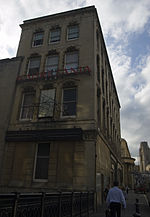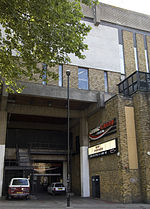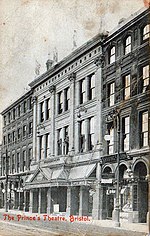Well Hung Lover

Well Hung Lover, also called Naked Man Hanging From Window and simply Naked Man, is a mural by the anonymous street artist Banksy, on a wall in Frogmore Street, Bristol, England. Painted in 2006 on the side of a sexual health clinic, it is the first legal piece of street art in the UK following a survey by Bristol City Council, resulting in retrospective permission and protection being granted for the mural, despite featuring nudity. It depicts a naked man hanging from a window, while a suited man looks out, next to a woman in her underwear. In 2009, the mural was defaced by a paintball gun, resulting in a partial restoration by the City Council. However, some paint splatters remain on the artwork. It was defaced a second time in 2018, with black spray paint.
Excerpt from the Wikipedia article Well Hung Lover (License: CC BY-SA 3.0, Authors, Images).Well Hung Lover
College Green, Bristol City Centre
Geographical coordinates (GPS) Address Nearby Places Show on map
Geographical coordinates (GPS)
| Latitude | Longitude |
|---|---|
| N 51.453 ° | E -2.601 ° |
Address
College Green
College Green
BS1 5SH Bristol, City Centre
England, United Kingdom
Open on Google Maps









